-
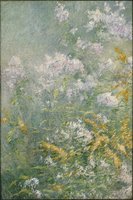 Meadow Flowers (Golden Rod and Wild Aster)
Meadow Flowers (Golden Rod and Wild Aster) Meadow Flowers is one of a small number of evocatively decorative Impressionist floral subjects that John Henry Twachtman completed after he moved to Greenwich, Connecticut, in 1889. This vertical canvas is among his most daring works because of its abstracted composition and expressive execution. Though clearly legible as flowers, the forms in the painting are effectively removed from the context of a clearly defined space. The absence of a horizon or measured recession highlights the richly textured paint surface and subtly animated pattern of the brushwork. The painting is further enriched by an opulent gilded frame designed by the architect Stanford White. (Source: Brooklyn Museum)
-
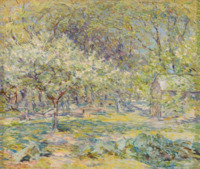 Apple Blossoms
Apple Blossoms Having studied at the Boston Museum School and the Art Students League in New York, Reid continued his studies in Paris in 1885. By the 1890s, the artist returned to New York where his style transitioned from academic naturalism to impressionism. His new subjects, women in outdoor settings, reveal that more and more, the artist was painting en plein air. The artist painted at the Cos Cob art colony with John H. Twachtman and was a member of the Ten American Painters group. (Source: Google Arts & Culture)
-
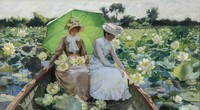 Lotus Lilies
Lotus Lilies In Charles Courtney Curran’s Lotus Lilies, two women sit together in a rowboat surrounded by lotus lilies that cover most of the visible surface of a lake, its low-lying shore visible in the distance. The sky is bright with the heat of a summer day, but the women are protected from the glare by hats, diaphanous veils, and a large green parasol. The woman on the right leans out of its shade to pluck lotus blossoms, which are gathered in the lap of her companion sheltering under the parasol aglow with transmitted light.
The foreshortened perspective on the boat, cut off at the lower edge of the picture, positions the observer vicariously as a member of the boating party. The women’s comfortable disregard of our gaze suggests the ease of familiarity. Indeed, Curran’s models were his new bride, Grace Winthrop Wickham, on the right, and her cousin, Charlotte "Lottie" Ada Taylor, on the left. The setting is Old Woman Creek, an estuary of Lake Erie in Ohio, where the Wickham family owned several summer cottages. The theme of lilies likely held special significance, for Grace carried a bouquet of water lilies at the couple’s wedding ceremony that summer.
At a time of unprecedented economic and industrial growth in the United States, artists increasingly turned to the subject of genteel leisure, as in Irving Ramsey Wiles’s On the Veranda (TF 1999.152) and Frederick Frieseke’s Lilies (TF 1999.55). Here, nestled among the lotuses, the two women are in harmony with the landscape. No sign of labor or exertion intrudes on the tranquil scene; for example, the rowboat lacks oars for propelling it across the water’s surface. Little effort is required by the women to approach the oversize blossoms that rise within easy reach on all sides. The lotus lily form is echoed in the framing of Lottie Taylor’s face by her bonnet and parasol. Evoking a longstanding association between women and flowers, Curran’s image implies a correspondence between the luxuriant pale blooms and the beautiful young women to suggest both sexual purity and virtuous natural fecundity. He also hints at the contrast between traditional confinement of women and the new prospects then opening for them. In contrast to Lottie’s old-fashioned bonnet, passive posture, and modest downward gaze, Grace, sporting a fashionable boater hat (adopted from men’s headgear), breaks out of the protected sphere defined by the parasol as she reaches beyond the confines of the boat.
Although Lotus Lilies predates Curran’s first trip to France in 1889, it demonstrates his awareness of the emerging aesthetic of impressionism. Like many Americans experimenting in the new mode, he tempered bold color and free brushwork with tight academic drawing and a balanced composition. Curran thought enough of Lotus Lilies to bring it with him to Paris, where he exhibited it at the prestigious Salon of 1890. Eminent critic Ernest Hoschedé praised the painting as "the best of modernity." In making contemporary life the subject of his ambitious painting, Curran followed a new trend that elevated everyday experience over historical, literary, and mythological subjects as the theme of high art. (Source: Terra Foundation for American Art)
-
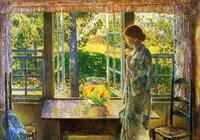 The Goldfish Window
The Goldfish Window Childe Hassam, for more than twenty years one of the country's leading Impressionist painters, began The Goldfish Window at the artists' colony in Cos Cob, Connecticut, in the summer of 1915 or 1916 and finished it in his New York studio in 1916. Hassam worked periodically at Cos Cob between 1894 and 1923, often staying at the famed Holley House, the gathering place for artists. Like a number of other members of the Cos Cob group, Hassam spent winters painting and exhibiting in New York and occasionally returned to France to renew his acquaintance with European styles. His 1910 trip to Paris, while reinforcing his commitment to the impressionists' focus on the effects of light, also renewed his interest in classicism and traditional formal problems. These concerns are paramount in a group of paintings, begun at about the time Hassam went abroad, that came to be known as the Windows series, The Goldfish Window is one of the most successful renderings of the theme.
In these paintings, a contemplative young woman is posed in front of a large window in a handsomely furnished interior, generally with a still-life arrangement on a table beside her. Sunshine pours in, backlighting the figure and creating a halo around her that adds to her ethereal beauty. Most of the Windows pictures were staged in Hassam's Manhattan studio. The Goldfish Window is unusual for having been painted at the Holley House; one of the summer colony's art students may have posed for the picture. The loose kimono in which the model is dressed may have been a studio prop of Hassam's, for other figures in the series wear similar robes. Yet it also reflects the general taste for aestheticism at Cos Cob, where students aspired to Oriental elegance, dressing up in kimonos and practicing flower arranging and tea ceremonies. The combination of Oriental objects (not the least of which is the glass bowl, filled with giant goldfish) with American antiques-the ladder-back, rush-seated chair and mid-eighteenth century, country-type table-is furthermore a reflection of Hassam's Boston roots. Just at this time, such Boston school painters as Frank Benson (q.v.) and Edmund Tarbell (q.v.) were painting similarly contrived, elegantly appointed interiors, with their typically Boston mix of New England antiques and Oriental objets d'art.
Hassam painted the last of the Windows pictures about 1920. They had been an important source of income and critical acclaim for him, winning prizes and selling quickly, quite a number of them to museums. In a 1927 interview, he described his interest in compositions such as these in purely formal terms: "[I enjoyed] using…figures with…flowers in an arrangement to make a beautiful combination of color and line." But as The Goldfish Window makes clear, these are also paintings of mood: the contrast between the brilliant, sunlit garden and the shadowy interior, painted in cool tones, reinforces the contemplative mood of the figure. The carefully structured room suggests both security and confinement, while the model's wistful gaze directs the viewer's eye to the relative freedom of the garden beyond. (Source: Currier Gallery of Art Collection Database)
-
 Seaside Flowers
Seaside Flowers Chase painted Seaside Flowers in Shinnecock, Long Island, where he taught art during the summer from 1892 to 1902. Chase encouraged his students to find beauty in landscapes that at first glance seem unremarkable, which he has done here. By breaking up the swath of scrubby bushes and grass with a diagonal slice of sea on the left and dirt path on the right, the artist enlivened a section of typical Long Island shoreline.
The figures include Chase’s wife, four of his daughters, whom he often painted, and an unknown boy, so the painting can be understood as a happy memento of summer vacation. However, the artist also used the people as compositional elements to add visual interest. He distributed them across the canvas in groups of one, two, and three, and their white clothes and verticality contrast with the green and blue horizontal bands of earth and sky. (Source: Google Arts & Culture)
-
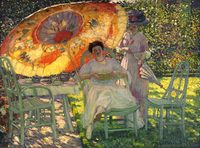 The Garden Parasol
The Garden Parasol When asked his artistic goals, Frederick Frieseke declared, “it is sunshine, flowers in sunshine; girls in sunshine; the nude in sunshine.” The emphasis upon light marks Frieseke as a disciple of the impressionists. However, in contrast to the impressionists, he focused his attention not on landscape but on the female figure and the private lives of women. Frieseke’s women were women as a worldly man might dream them, sensual and ornamental, engaged in polite, domestic, “feminine” pursuits: dressing (or undressing), arranging flowers, lounging on a divan, or, as here, taking tea in the garden.
The Garden Parasol evokes the serene pleasure of a summer in the French countryside. The setting is the garden of the Friesekes’ house at Giverny, close to the home and gardens of the venerable impressionist painter Claude Monet. The seated woman is the artist’s wife, Sadie, and the garden was her special creation. Frieseke depicts her as a cultivated woman of leisure whose reading is interrupted by the arrival of a visitor-or visitors, for it is our approach that distracts Sadie from her book and prompts her to fix us with a questioning stare. Whatever small drama might arise from so genteel an encounter is fully upstaged by the vibrancy of the garden, and especially by the Japanese parasol that spices the scene with swirling colors. (Source: North Carolina Museum of Art Collection Database)
-
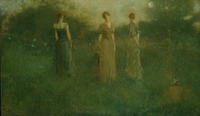 In the Garden
In the Garden Thomas Wilmer Dewing was an American painter working at the turn of the 20th century. Schooled in Paris, Dewing was noted for his figure paintings of aristocratic women. He was a founding member of the Ten American Painters and taught at the Art Students League of New York. The Freer Gallery of Art at the Smithsonian Institution has a collection of his works. He was the husband of fellow artist Maria Oakey Dewing.
-
 In the Garden (Celia Thaxter in Her Garden)
In the Garden (Celia Thaxter in Her Garden) Childe Hassam spent many summers on Appledore Island off the coast of Maine, drawing artistic inspiration from the rocky coast and brilliant wildflowers that grew there. Every year, he and a group of musicians, writers, and artists made
an informal colony based at the home of the poet Celia Thaxter. Among this prominent circle of friends were novelist Nathaniel Hawthorne, poets Ralph Waldo Emerson and Henry Wadsworth Longfellow, and artist William Morris Hunt. Art, music, gardening, poetry readings, and intellectual banter were part of Thaxter’s everyday life on Appledore, where she and her family operated a hotel, the Appledore House.
Hassam’s painting shows Thaxter strolling through her garden, pausing to admire the many beautiful wildflowers that have flourished thanks to her care. She spent several hours each day tending to her garden, renowned for its beauty. It provided inspiration for her 1894 memoir, An Island Garden, which Hassam illustrated. The myriad of flowers Thaxter walks through seem to mimic the undulating waves of the ocean in the distance, the summer sea breeze gently swaying the flowers and grasses side to side. Of her flowers, Thaxter wrote, “Ever since I could remember anything, flowers have been like dear friends to me, comforters, inspirers, powers to uplift and to cheer. A lonely child, living on the lighthouse island...every blade of grass that sprang out of the ground, every humblest weed, was precious in my sight.”
Sailboats glide across the water in the background, their white sails unfurled with the ocean breeze. A rustic split-rail fence is barely visible under the weight of numerous blooms, which creep up the sides of the composition, creating a framing device for the figure of Celia Thaxter. In Thaxter’s gardens and on the rocky beaches, Hassam used the flickering brushwork and brilliant colors of impressionist art he had acquired in France to capture the spangled light of Appledore’s brief summer. The painting evokes the leisurely, seasonal rhythms of America’s privileged families in the years before World War I, known as the Gilded Age. Situated on an island, this scene seems far removed from the larger issues Americans faced at the time, such as income inequality and mass immigration. (Source: Smithsonian American Art Museum)
-
 Lady in a Garden
Lady in a Garden The figure of a woman standing in profile seems visually overwhelmed and almost consumed in a riot of blossoms and leaves crowded into a luxuriant garden in Frederick Frieseke’s Lady in a Garden. The massed plants fill the composition to its edges, leaving only a glimpse, near the upper right corner, of two light-green shutters on the wall of a house. Spontaneous spots and dashes of thick pigment in pure color suggest a variety of plant forms and textures while creating an overall flickering effect to mimic the shimmering of the varied surfaces of flowers and foliage in brilliant sunlight. The woman’s striped dress seems a playful outgrowth of the dense tapestry of slender blades by which her lower body is completely screened.
The green shutters in the background suggest that Lady in a Garden, like many other outdoor works by Frieseke, may have been painted in the garden of Le Hameau, the house he occupied in the rural village of Giverny, France. Frieseke and his wife lived in the village every summer between 1906 and 1919, joining a lively artist's colony composed largely of American expatriates who painted using the divided brushstrokes, pure color, and bright light effects of impressionism as originally pioneered by Giverny’s most famous resident, painter Claude Monet (1840–1926). With the green-shuttered house in the background, their garden, avidly cultivated by Mrs. Frieseke, served as the setting for many other works, including the Breakfast in the Garden (TF 1987.21) and Lilies (TF 1999.55). While Mrs. Frieseke often modeled for these works, the identity of the woman in Lady in a Garden has not been confirmed. Her distinctive dress, however, appears in other paintings that verify that its bold stripes, here tinted pale green and lavender by reflections from the surrounding leaves and flowers, were simply black and white.
Frieseke often pictured the garden, like his interior settings, as the site of social and domestic activity, such as open-air meals and relaxed conversation. In other works, however, he concentrated on the formal possibilities and purely visual appeal of the female figure posed within a setting characterized by vivid contrasting pattern, whether provided by wallpaper, the fabric of clothing and upholstery, or, as here, garden foliage and flowers. With the figure nearly dissolved in the vivid mosaic of spots and dashes that describe her surroundings, Lady in a Garden takes Frieseke’s experimentation with purely decorative painting to its furthest extent. It incorporates the spontaneous painting technique and garden settings of impressionism and the emphasis on pure pattern, expressive color, and decorative design associated with the French painters known as Les Nabis (“the prophets”). (Source: Terra Foundation Collection Database)
-
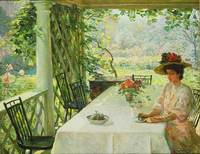 On the Piazza
On the Piazza An Impressionistic scene of a woman sitting at a dining table on the side porch of the Florence Griswold House c. 1908. The garden and trellis flowers are in full bloom. Glasses, fruit, and flowers are set on the table, which is covered with a white tablecloth. Five Windsor chairs and a wooden box also are seen on the porch. According to the donor, the woman in a large flowered hat is an unidentified model. (Source: Florence Griswold Museum Collection Database)
-
 Garden in May
Garden in May Maria Oakey Dewing and her husband, Thomas Wilmer Dewing, spent the summers from 1885 to 1905 at an artists' colony in Cornish, New Hampshire. There they cultivated the large garden that Maria studied and painted. In Garden in May [SAAM, 1929.6.26] the viewer has a "worm's-eye view" of a bed of carnations and roses. Dewing places the viewer among the living stems and blossoms that she knew so well. She has cropped a section from the larger bed for intense study, as if she had held a frame in front of the garden and painted only what fit in the rectangle. (Source: SAAM database)
-
 Garden Study of the Vickers Children
Garden Study of the Vickers Children Dorothy (ca. 1878–1949) and Billy (1879–1939) were the children of Albert and Edith Vickers, Sargent’s most important British patrons in the 1880s. This is one of several informal portraits Sargent created during his stay at the family’s home in Sussex. The two young children appear in an indeterminate garden setting. Sargent tilts the picture plane and eliminates the horizon to create a flat space. The lilies seem to float on the verdant field, producing a highly decorative effect. The association between children and lilies (a symbol of innocence and purity) places the image in a Victorian context, while the unorthodox composition evokes the work of such diverse artists as Édouard Manet and the Pre-Raphaelites.
-
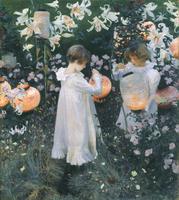 Carnation, Lily, Lily, Rose
Carnation, Lily, Lily, Rose The children lighting lanterns are Dolly (left) and Polly (right) Barnard. Their father, illustrator Frederick Barnard, was friends with Sargent. It was painted in a garden in Broadway, a village in south west England where Sargent stayed in the summer of 1885. Sargent wanted to paint from real life. There were only a few minutes each evening where the light was right. He would place his easel and paints, pose the models beforehand, and wait for the right moment to start. As summer ended and the flowers died, he replaced them with pot plants. (Source: TATE Museum Collection database)
-
 Hollyhocks
Hollyhocks This painting clearly exemplifies Frieseke's method, which he succinctly explained to Clara MacChesney: "If you are looking at a mass of flowers in the sunlight out of doors you see a sparkle of spots of different colors-then paint them that way." It was Frieseke's dealer and friend Robert Macbeth who, at the artist's request, chose this painting to be presented to the Academy. (Source: Google Arts & Culture)
-
 The Crimson Rambler
The Crimson Rambler "The Crimson Rambler," purchased after its exhibition in the 1909 Pennsylvania Academy annual, is typical of Hale's impressionist style, with its linear treatment of the figure in a freely brushed setting of light and color. Hale's specialization in visions of idle, decorative women of fragile, "floral" beauty has been interpreted as a visual response to his objection to the women's suffrage movement. It was painted at the home Hale shared with his wife, the painter Lilian Westcott Hale, in the Boston suburb of Dedham; the couple's daughter Nancy has identified the sitter as Rose Zeffler. (Source: Pennsylvania Academy of the Fine Arts database)
-
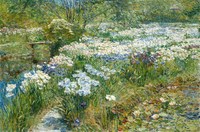 The Water Garden
The Water Garden This intimate landscape, with its strong rhythmic composition, flattened space, and tapestry-like application of paint, illustrates the modification of Hassam's style at the turn of the century when he absorbed Post-Impressionist developments. The painting is thought to have been executed on the property of a friend in East Hampton who had a beautiful lily pond surrounded by irises. Hassam was later to buy his own home in East Hampton, where he spent long periods during the last sixteen years of his life. (Source: MET Museum Collection database)
-
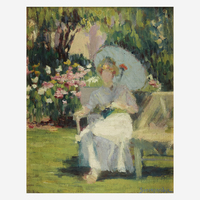 Portrait of Alice L. Riddle Kindler in the Phlox Garden
Portrait of Alice L. Riddle Kindler in the Phlox Garden Signed 'Breckenridge' bottom right; also inscribed 'Painted at/Breckenridge's Summer School/at Mt. Washington PA/Summer 1911 or 1912/Subject: later wife of Hans Kindler - Cellist' verso, oil on canvas laid down to board (Source: Freedman's Lot page)
-
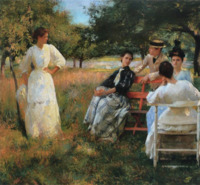 In the Orchard
In the Orchard In the Orchard is Edmund C. Tarbell’s image of his wife, Emeline Souther Tarbell, her siblings, and a family friend conversing in a bucolic setting on a summer’s afternoon. The figures have been identified as the artist’s sister-in-law, Lydia, standing at left and shown again, seated and with her back to the viewer, on the right; Lemira Eastman, a family friend, in dark blue; Richmond Souther, leaning over the back of the red bench; and Emeline, wearing a black hat and looking directly at the viewer. Poses and glances tie the five together in an intimate, convivial circle in the beneficent dappled sunlight of the orchard, which stretches away to a white fence in the distance. The work’s informal, contemporary subject, outdoor setting, and bright colors in distinct, rapidly applied paint strokes are hallmarks of the movement known as impressionism, which Americans such as Tarbell emulated from contemporary French artists. (Source: Terra Foundation database)
-
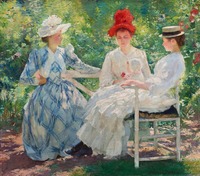 Three Sisters— A Study in June Sunlight
Three Sisters— A Study in June Sunlight The subtitle of this first important Impressionist work by Edmund Tarbell is a clear indication of his interest in the new French style just recently introduced in America. The painting’s dappled light, brilliant palette, and short, textured brush strokes caused a sensation when it was exhibited in Tarbell’s hometown of Boston. The transient light and undiluted color create a warm atmosphere in which the figures are more solidly drawn. Posing his wife, her sisters, and his baby daughter in a lovely garden setting, Tarbell did not attempt probing portraits but instead sought to portray an affluent and tranquil way of life. The inclusion of the American colonial chair implies their New England heritage that underlies this seemingly French aesthetic. (Source: Excerpt from Collection Guide: Milwaukee Art Museum. Milwaukee: Milwaukee Art Museum, 2004, pp. 34, 70, cat. 51.)
-
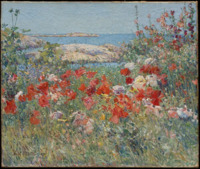 Celia Thaxter's Garden, Isles of Shoals, Maine
Celia Thaxter's Garden, Isles of Shoals, Maine This painting is one of the finest of a series of works that Hassam made during summers in the 1890s on Appledore Island, one of the Isles of Shoals, which lie ten miles east of Portsmouth, New Hampshire. This series portrays the sumptuous wildflower garden cultivated by his friend, poet Celia Thaxter, a garden that provided a marvelous contrast to the rugged terrain of the island itself. In this painting, vibrant red poppies entangled in lush green foliage introduce a view of bleached Babb's Rock. The painting shows Hassam at the height of his creativity as an American Impressionist. (Source: MET Museum Collection database)
 Meadow Flowers (Golden Rod and Wild Aster) Meadow Flowers is one of a small number of evocatively decorative Impressionist floral subjects that John Henry Twachtman completed after he moved to Greenwich, Connecticut, in 1889. This vertical canvas is among his most daring works because of its abstracted composition and expressive execution. Though clearly legible as flowers, the forms in the painting are effectively removed from the context of a clearly defined space. The absence of a horizon or measured recession highlights the richly textured paint surface and subtly animated pattern of the brushwork. The painting is further enriched by an opulent gilded frame designed by the architect Stanford White. (Source: Brooklyn Museum)
Meadow Flowers (Golden Rod and Wild Aster) Meadow Flowers is one of a small number of evocatively decorative Impressionist floral subjects that John Henry Twachtman completed after he moved to Greenwich, Connecticut, in 1889. This vertical canvas is among his most daring works because of its abstracted composition and expressive execution. Though clearly legible as flowers, the forms in the painting are effectively removed from the context of a clearly defined space. The absence of a horizon or measured recession highlights the richly textured paint surface and subtly animated pattern of the brushwork. The painting is further enriched by an opulent gilded frame designed by the architect Stanford White. (Source: Brooklyn Museum) Apple Blossoms Having studied at the Boston Museum School and the Art Students League in New York, Reid continued his studies in Paris in 1885. By the 1890s, the artist returned to New York where his style transitioned from academic naturalism to impressionism. His new subjects, women in outdoor settings, reveal that more and more, the artist was painting en plein air. The artist painted at the Cos Cob art colony with John H. Twachtman and was a member of the Ten American Painters group. (Source: Google Arts & Culture)
Apple Blossoms Having studied at the Boston Museum School and the Art Students League in New York, Reid continued his studies in Paris in 1885. By the 1890s, the artist returned to New York where his style transitioned from academic naturalism to impressionism. His new subjects, women in outdoor settings, reveal that more and more, the artist was painting en plein air. The artist painted at the Cos Cob art colony with John H. Twachtman and was a member of the Ten American Painters group. (Source: Google Arts & Culture) Lotus Lilies In Charles Courtney Curran’s Lotus Lilies, two women sit together in a rowboat surrounded by lotus lilies that cover most of the visible surface of a lake, its low-lying shore visible in the distance. The sky is bright with the heat of a summer day, but the women are protected from the glare by hats, diaphanous veils, and a large green parasol. The woman on the right leans out of its shade to pluck lotus blossoms, which are gathered in the lap of her companion sheltering under the parasol aglow with transmitted light. The foreshortened perspective on the boat, cut off at the lower edge of the picture, positions the observer vicariously as a member of the boating party. The women’s comfortable disregard of our gaze suggests the ease of familiarity. Indeed, Curran’s models were his new bride, Grace Winthrop Wickham, on the right, and her cousin, Charlotte "Lottie" Ada Taylor, on the left. The setting is Old Woman Creek, an estuary of Lake Erie in Ohio, where the Wickham family owned several summer cottages. The theme of lilies likely held special significance, for Grace carried a bouquet of water lilies at the couple’s wedding ceremony that summer. At a time of unprecedented economic and industrial growth in the United States, artists increasingly turned to the subject of genteel leisure, as in Irving Ramsey Wiles’s On the Veranda (TF 1999.152) and Frederick Frieseke’s Lilies (TF 1999.55). Here, nestled among the lotuses, the two women are in harmony with the landscape. No sign of labor or exertion intrudes on the tranquil scene; for example, the rowboat lacks oars for propelling it across the water’s surface. Little effort is required by the women to approach the oversize blossoms that rise within easy reach on all sides. The lotus lily form is echoed in the framing of Lottie Taylor’s face by her bonnet and parasol. Evoking a longstanding association between women and flowers, Curran’s image implies a correspondence between the luxuriant pale blooms and the beautiful young women to suggest both sexual purity and virtuous natural fecundity. He also hints at the contrast between traditional confinement of women and the new prospects then opening for them. In contrast to Lottie’s old-fashioned bonnet, passive posture, and modest downward gaze, Grace, sporting a fashionable boater hat (adopted from men’s headgear), breaks out of the protected sphere defined by the parasol as she reaches beyond the confines of the boat. Although Lotus Lilies predates Curran’s first trip to France in 1889, it demonstrates his awareness of the emerging aesthetic of impressionism. Like many Americans experimenting in the new mode, he tempered bold color and free brushwork with tight academic drawing and a balanced composition. Curran thought enough of Lotus Lilies to bring it with him to Paris, where he exhibited it at the prestigious Salon of 1890. Eminent critic Ernest Hoschedé praised the painting as "the best of modernity." In making contemporary life the subject of his ambitious painting, Curran followed a new trend that elevated everyday experience over historical, literary, and mythological subjects as the theme of high art. (Source: Terra Foundation for American Art)
Lotus Lilies In Charles Courtney Curran’s Lotus Lilies, two women sit together in a rowboat surrounded by lotus lilies that cover most of the visible surface of a lake, its low-lying shore visible in the distance. The sky is bright with the heat of a summer day, but the women are protected from the glare by hats, diaphanous veils, and a large green parasol. The woman on the right leans out of its shade to pluck lotus blossoms, which are gathered in the lap of her companion sheltering under the parasol aglow with transmitted light. The foreshortened perspective on the boat, cut off at the lower edge of the picture, positions the observer vicariously as a member of the boating party. The women’s comfortable disregard of our gaze suggests the ease of familiarity. Indeed, Curran’s models were his new bride, Grace Winthrop Wickham, on the right, and her cousin, Charlotte "Lottie" Ada Taylor, on the left. The setting is Old Woman Creek, an estuary of Lake Erie in Ohio, where the Wickham family owned several summer cottages. The theme of lilies likely held special significance, for Grace carried a bouquet of water lilies at the couple’s wedding ceremony that summer. At a time of unprecedented economic and industrial growth in the United States, artists increasingly turned to the subject of genteel leisure, as in Irving Ramsey Wiles’s On the Veranda (TF 1999.152) and Frederick Frieseke’s Lilies (TF 1999.55). Here, nestled among the lotuses, the two women are in harmony with the landscape. No sign of labor or exertion intrudes on the tranquil scene; for example, the rowboat lacks oars for propelling it across the water’s surface. Little effort is required by the women to approach the oversize blossoms that rise within easy reach on all sides. The lotus lily form is echoed in the framing of Lottie Taylor’s face by her bonnet and parasol. Evoking a longstanding association between women and flowers, Curran’s image implies a correspondence between the luxuriant pale blooms and the beautiful young women to suggest both sexual purity and virtuous natural fecundity. He also hints at the contrast between traditional confinement of women and the new prospects then opening for them. In contrast to Lottie’s old-fashioned bonnet, passive posture, and modest downward gaze, Grace, sporting a fashionable boater hat (adopted from men’s headgear), breaks out of the protected sphere defined by the parasol as she reaches beyond the confines of the boat. Although Lotus Lilies predates Curran’s first trip to France in 1889, it demonstrates his awareness of the emerging aesthetic of impressionism. Like many Americans experimenting in the new mode, he tempered bold color and free brushwork with tight academic drawing and a balanced composition. Curran thought enough of Lotus Lilies to bring it with him to Paris, where he exhibited it at the prestigious Salon of 1890. Eminent critic Ernest Hoschedé praised the painting as "the best of modernity." In making contemporary life the subject of his ambitious painting, Curran followed a new trend that elevated everyday experience over historical, literary, and mythological subjects as the theme of high art. (Source: Terra Foundation for American Art) The Goldfish Window Childe Hassam, for more than twenty years one of the country's leading Impressionist painters, began The Goldfish Window at the artists' colony in Cos Cob, Connecticut, in the summer of 1915 or 1916 and finished it in his New York studio in 1916. Hassam worked periodically at Cos Cob between 1894 and 1923, often staying at the famed Holley House, the gathering place for artists. Like a number of other members of the Cos Cob group, Hassam spent winters painting and exhibiting in New York and occasionally returned to France to renew his acquaintance with European styles. His 1910 trip to Paris, while reinforcing his commitment to the impressionists' focus on the effects of light, also renewed his interest in classicism and traditional formal problems. These concerns are paramount in a group of paintings, begun at about the time Hassam went abroad, that came to be known as the Windows series, The Goldfish Window is one of the most successful renderings of the theme. In these paintings, a contemplative young woman is posed in front of a large window in a handsomely furnished interior, generally with a still-life arrangement on a table beside her. Sunshine pours in, backlighting the figure and creating a halo around her that adds to her ethereal beauty. Most of the Windows pictures were staged in Hassam's Manhattan studio. The Goldfish Window is unusual for having been painted at the Holley House; one of the summer colony's art students may have posed for the picture. The loose kimono in which the model is dressed may have been a studio prop of Hassam's, for other figures in the series wear similar robes. Yet it also reflects the general taste for aestheticism at Cos Cob, where students aspired to Oriental elegance, dressing up in kimonos and practicing flower arranging and tea ceremonies. The combination of Oriental objects (not the least of which is the glass bowl, filled with giant goldfish) with American antiques-the ladder-back, rush-seated chair and mid-eighteenth century, country-type table-is furthermore a reflection of Hassam's Boston roots. Just at this time, such Boston school painters as Frank Benson (q.v.) and Edmund Tarbell (q.v.) were painting similarly contrived, elegantly appointed interiors, with their typically Boston mix of New England antiques and Oriental objets d'art. Hassam painted the last of the Windows pictures about 1920. They had been an important source of income and critical acclaim for him, winning prizes and selling quickly, quite a number of them to museums. In a 1927 interview, he described his interest in compositions such as these in purely formal terms: "[I enjoyed] using…figures with…flowers in an arrangement to make a beautiful combination of color and line." But as The Goldfish Window makes clear, these are also paintings of mood: the contrast between the brilliant, sunlit garden and the shadowy interior, painted in cool tones, reinforces the contemplative mood of the figure. The carefully structured room suggests both security and confinement, while the model's wistful gaze directs the viewer's eye to the relative freedom of the garden beyond. (Source: Currier Gallery of Art Collection Database)
The Goldfish Window Childe Hassam, for more than twenty years one of the country's leading Impressionist painters, began The Goldfish Window at the artists' colony in Cos Cob, Connecticut, in the summer of 1915 or 1916 and finished it in his New York studio in 1916. Hassam worked periodically at Cos Cob between 1894 and 1923, often staying at the famed Holley House, the gathering place for artists. Like a number of other members of the Cos Cob group, Hassam spent winters painting and exhibiting in New York and occasionally returned to France to renew his acquaintance with European styles. His 1910 trip to Paris, while reinforcing his commitment to the impressionists' focus on the effects of light, also renewed his interest in classicism and traditional formal problems. These concerns are paramount in a group of paintings, begun at about the time Hassam went abroad, that came to be known as the Windows series, The Goldfish Window is one of the most successful renderings of the theme. In these paintings, a contemplative young woman is posed in front of a large window in a handsomely furnished interior, generally with a still-life arrangement on a table beside her. Sunshine pours in, backlighting the figure and creating a halo around her that adds to her ethereal beauty. Most of the Windows pictures were staged in Hassam's Manhattan studio. The Goldfish Window is unusual for having been painted at the Holley House; one of the summer colony's art students may have posed for the picture. The loose kimono in which the model is dressed may have been a studio prop of Hassam's, for other figures in the series wear similar robes. Yet it also reflects the general taste for aestheticism at Cos Cob, where students aspired to Oriental elegance, dressing up in kimonos and practicing flower arranging and tea ceremonies. The combination of Oriental objects (not the least of which is the glass bowl, filled with giant goldfish) with American antiques-the ladder-back, rush-seated chair and mid-eighteenth century, country-type table-is furthermore a reflection of Hassam's Boston roots. Just at this time, such Boston school painters as Frank Benson (q.v.) and Edmund Tarbell (q.v.) were painting similarly contrived, elegantly appointed interiors, with their typically Boston mix of New England antiques and Oriental objets d'art. Hassam painted the last of the Windows pictures about 1920. They had been an important source of income and critical acclaim for him, winning prizes and selling quickly, quite a number of them to museums. In a 1927 interview, he described his interest in compositions such as these in purely formal terms: "[I enjoyed] using…figures with…flowers in an arrangement to make a beautiful combination of color and line." But as The Goldfish Window makes clear, these are also paintings of mood: the contrast between the brilliant, sunlit garden and the shadowy interior, painted in cool tones, reinforces the contemplative mood of the figure. The carefully structured room suggests both security and confinement, while the model's wistful gaze directs the viewer's eye to the relative freedom of the garden beyond. (Source: Currier Gallery of Art Collection Database) Seaside Flowers Chase painted Seaside Flowers in Shinnecock, Long Island, where he taught art during the summer from 1892 to 1902. Chase encouraged his students to find beauty in landscapes that at first glance seem unremarkable, which he has done here. By breaking up the swath of scrubby bushes and grass with a diagonal slice of sea on the left and dirt path on the right, the artist enlivened a section of typical Long Island shoreline. The figures include Chase’s wife, four of his daughters, whom he often painted, and an unknown boy, so the painting can be understood as a happy memento of summer vacation. However, the artist also used the people as compositional elements to add visual interest. He distributed them across the canvas in groups of one, two, and three, and their white clothes and verticality contrast with the green and blue horizontal bands of earth and sky. (Source: Google Arts & Culture)
Seaside Flowers Chase painted Seaside Flowers in Shinnecock, Long Island, where he taught art during the summer from 1892 to 1902. Chase encouraged his students to find beauty in landscapes that at first glance seem unremarkable, which he has done here. By breaking up the swath of scrubby bushes and grass with a diagonal slice of sea on the left and dirt path on the right, the artist enlivened a section of typical Long Island shoreline. The figures include Chase’s wife, four of his daughters, whom he often painted, and an unknown boy, so the painting can be understood as a happy memento of summer vacation. However, the artist also used the people as compositional elements to add visual interest. He distributed them across the canvas in groups of one, two, and three, and their white clothes and verticality contrast with the green and blue horizontal bands of earth and sky. (Source: Google Arts & Culture) The Garden Parasol When asked his artistic goals, Frederick Frieseke declared, “it is sunshine, flowers in sunshine; girls in sunshine; the nude in sunshine.” The emphasis upon light marks Frieseke as a disciple of the impressionists. However, in contrast to the impressionists, he focused his attention not on landscape but on the female figure and the private lives of women. Frieseke’s women were women as a worldly man might dream them, sensual and ornamental, engaged in polite, domestic, “feminine” pursuits: dressing (or undressing), arranging flowers, lounging on a divan, or, as here, taking tea in the garden. The Garden Parasol evokes the serene pleasure of a summer in the French countryside. The setting is the garden of the Friesekes’ house at Giverny, close to the home and gardens of the venerable impressionist painter Claude Monet. The seated woman is the artist’s wife, Sadie, and the garden was her special creation. Frieseke depicts her as a cultivated woman of leisure whose reading is interrupted by the arrival of a visitor-or visitors, for it is our approach that distracts Sadie from her book and prompts her to fix us with a questioning stare. Whatever small drama might arise from so genteel an encounter is fully upstaged by the vibrancy of the garden, and especially by the Japanese parasol that spices the scene with swirling colors. (Source: North Carolina Museum of Art Collection Database)
The Garden Parasol When asked his artistic goals, Frederick Frieseke declared, “it is sunshine, flowers in sunshine; girls in sunshine; the nude in sunshine.” The emphasis upon light marks Frieseke as a disciple of the impressionists. However, in contrast to the impressionists, he focused his attention not on landscape but on the female figure and the private lives of women. Frieseke’s women were women as a worldly man might dream them, sensual and ornamental, engaged in polite, domestic, “feminine” pursuits: dressing (or undressing), arranging flowers, lounging on a divan, or, as here, taking tea in the garden. The Garden Parasol evokes the serene pleasure of a summer in the French countryside. The setting is the garden of the Friesekes’ house at Giverny, close to the home and gardens of the venerable impressionist painter Claude Monet. The seated woman is the artist’s wife, Sadie, and the garden was her special creation. Frieseke depicts her as a cultivated woman of leisure whose reading is interrupted by the arrival of a visitor-or visitors, for it is our approach that distracts Sadie from her book and prompts her to fix us with a questioning stare. Whatever small drama might arise from so genteel an encounter is fully upstaged by the vibrancy of the garden, and especially by the Japanese parasol that spices the scene with swirling colors. (Source: North Carolina Museum of Art Collection Database) In the Garden Thomas Wilmer Dewing was an American painter working at the turn of the 20th century. Schooled in Paris, Dewing was noted for his figure paintings of aristocratic women. He was a founding member of the Ten American Painters and taught at the Art Students League of New York. The Freer Gallery of Art at the Smithsonian Institution has a collection of his works. He was the husband of fellow artist Maria Oakey Dewing.
In the Garden Thomas Wilmer Dewing was an American painter working at the turn of the 20th century. Schooled in Paris, Dewing was noted for his figure paintings of aristocratic women. He was a founding member of the Ten American Painters and taught at the Art Students League of New York. The Freer Gallery of Art at the Smithsonian Institution has a collection of his works. He was the husband of fellow artist Maria Oakey Dewing. In the Garden (Celia Thaxter in Her Garden) Childe Hassam spent many summers on Appledore Island off the coast of Maine, drawing artistic inspiration from the rocky coast and brilliant wildflowers that grew there. Every year, he and a group of musicians, writers, and artists made an informal colony based at the home of the poet Celia Thaxter. Among this prominent circle of friends were novelist Nathaniel Hawthorne, poets Ralph Waldo Emerson and Henry Wadsworth Longfellow, and artist William Morris Hunt. Art, music, gardening, poetry readings, and intellectual banter were part of Thaxter’s everyday life on Appledore, where she and her family operated a hotel, the Appledore House. Hassam’s painting shows Thaxter strolling through her garden, pausing to admire the many beautiful wildflowers that have flourished thanks to her care. She spent several hours each day tending to her garden, renowned for its beauty. It provided inspiration for her 1894 memoir, An Island Garden, which Hassam illustrated. The myriad of flowers Thaxter walks through seem to mimic the undulating waves of the ocean in the distance, the summer sea breeze gently swaying the flowers and grasses side to side. Of her flowers, Thaxter wrote, “Ever since I could remember anything, flowers have been like dear friends to me, comforters, inspirers, powers to uplift and to cheer. A lonely child, living on the lighthouse island...every blade of grass that sprang out of the ground, every humblest weed, was precious in my sight.” Sailboats glide across the water in the background, their white sails unfurled with the ocean breeze. A rustic split-rail fence is barely visible under the weight of numerous blooms, which creep up the sides of the composition, creating a framing device for the figure of Celia Thaxter. In Thaxter’s gardens and on the rocky beaches, Hassam used the flickering brushwork and brilliant colors of impressionist art he had acquired in France to capture the spangled light of Appledore’s brief summer. The painting evokes the leisurely, seasonal rhythms of America’s privileged families in the years before World War I, known as the Gilded Age. Situated on an island, this scene seems far removed from the larger issues Americans faced at the time, such as income inequality and mass immigration. (Source: Smithsonian American Art Museum)
In the Garden (Celia Thaxter in Her Garden) Childe Hassam spent many summers on Appledore Island off the coast of Maine, drawing artistic inspiration from the rocky coast and brilliant wildflowers that grew there. Every year, he and a group of musicians, writers, and artists made an informal colony based at the home of the poet Celia Thaxter. Among this prominent circle of friends were novelist Nathaniel Hawthorne, poets Ralph Waldo Emerson and Henry Wadsworth Longfellow, and artist William Morris Hunt. Art, music, gardening, poetry readings, and intellectual banter were part of Thaxter’s everyday life on Appledore, where she and her family operated a hotel, the Appledore House. Hassam’s painting shows Thaxter strolling through her garden, pausing to admire the many beautiful wildflowers that have flourished thanks to her care. She spent several hours each day tending to her garden, renowned for its beauty. It provided inspiration for her 1894 memoir, An Island Garden, which Hassam illustrated. The myriad of flowers Thaxter walks through seem to mimic the undulating waves of the ocean in the distance, the summer sea breeze gently swaying the flowers and grasses side to side. Of her flowers, Thaxter wrote, “Ever since I could remember anything, flowers have been like dear friends to me, comforters, inspirers, powers to uplift and to cheer. A lonely child, living on the lighthouse island...every blade of grass that sprang out of the ground, every humblest weed, was precious in my sight.” Sailboats glide across the water in the background, their white sails unfurled with the ocean breeze. A rustic split-rail fence is barely visible under the weight of numerous blooms, which creep up the sides of the composition, creating a framing device for the figure of Celia Thaxter. In Thaxter’s gardens and on the rocky beaches, Hassam used the flickering brushwork and brilliant colors of impressionist art he had acquired in France to capture the spangled light of Appledore’s brief summer. The painting evokes the leisurely, seasonal rhythms of America’s privileged families in the years before World War I, known as the Gilded Age. Situated on an island, this scene seems far removed from the larger issues Americans faced at the time, such as income inequality and mass immigration. (Source: Smithsonian American Art Museum) Lady in a Garden The figure of a woman standing in profile seems visually overwhelmed and almost consumed in a riot of blossoms and leaves crowded into a luxuriant garden in Frederick Frieseke’s Lady in a Garden. The massed plants fill the composition to its edges, leaving only a glimpse, near the upper right corner, of two light-green shutters on the wall of a house. Spontaneous spots and dashes of thick pigment in pure color suggest a variety of plant forms and textures while creating an overall flickering effect to mimic the shimmering of the varied surfaces of flowers and foliage in brilliant sunlight. The woman’s striped dress seems a playful outgrowth of the dense tapestry of slender blades by which her lower body is completely screened. The green shutters in the background suggest that Lady in a Garden, like many other outdoor works by Frieseke, may have been painted in the garden of Le Hameau, the house he occupied in the rural village of Giverny, France. Frieseke and his wife lived in the village every summer between 1906 and 1919, joining a lively artist's colony composed largely of American expatriates who painted using the divided brushstrokes, pure color, and bright light effects of impressionism as originally pioneered by Giverny’s most famous resident, painter Claude Monet (1840–1926). With the green-shuttered house in the background, their garden, avidly cultivated by Mrs. Frieseke, served as the setting for many other works, including the Breakfast in the Garden (TF 1987.21) and Lilies (TF 1999.55). While Mrs. Frieseke often modeled for these works, the identity of the woman in Lady in a Garden has not been confirmed. Her distinctive dress, however, appears in other paintings that verify that its bold stripes, here tinted pale green and lavender by reflections from the surrounding leaves and flowers, were simply black and white. Frieseke often pictured the garden, like his interior settings, as the site of social and domestic activity, such as open-air meals and relaxed conversation. In other works, however, he concentrated on the formal possibilities and purely visual appeal of the female figure posed within a setting characterized by vivid contrasting pattern, whether provided by wallpaper, the fabric of clothing and upholstery, or, as here, garden foliage and flowers. With the figure nearly dissolved in the vivid mosaic of spots and dashes that describe her surroundings, Lady in a Garden takes Frieseke’s experimentation with purely decorative painting to its furthest extent. It incorporates the spontaneous painting technique and garden settings of impressionism and the emphasis on pure pattern, expressive color, and decorative design associated with the French painters known as Les Nabis (“the prophets”). (Source: Terra Foundation Collection Database)
Lady in a Garden The figure of a woman standing in profile seems visually overwhelmed and almost consumed in a riot of blossoms and leaves crowded into a luxuriant garden in Frederick Frieseke’s Lady in a Garden. The massed plants fill the composition to its edges, leaving only a glimpse, near the upper right corner, of two light-green shutters on the wall of a house. Spontaneous spots and dashes of thick pigment in pure color suggest a variety of plant forms and textures while creating an overall flickering effect to mimic the shimmering of the varied surfaces of flowers and foliage in brilliant sunlight. The woman’s striped dress seems a playful outgrowth of the dense tapestry of slender blades by which her lower body is completely screened. The green shutters in the background suggest that Lady in a Garden, like many other outdoor works by Frieseke, may have been painted in the garden of Le Hameau, the house he occupied in the rural village of Giverny, France. Frieseke and his wife lived in the village every summer between 1906 and 1919, joining a lively artist's colony composed largely of American expatriates who painted using the divided brushstrokes, pure color, and bright light effects of impressionism as originally pioneered by Giverny’s most famous resident, painter Claude Monet (1840–1926). With the green-shuttered house in the background, their garden, avidly cultivated by Mrs. Frieseke, served as the setting for many other works, including the Breakfast in the Garden (TF 1987.21) and Lilies (TF 1999.55). While Mrs. Frieseke often modeled for these works, the identity of the woman in Lady in a Garden has not been confirmed. Her distinctive dress, however, appears in other paintings that verify that its bold stripes, here tinted pale green and lavender by reflections from the surrounding leaves and flowers, were simply black and white. Frieseke often pictured the garden, like his interior settings, as the site of social and domestic activity, such as open-air meals and relaxed conversation. In other works, however, he concentrated on the formal possibilities and purely visual appeal of the female figure posed within a setting characterized by vivid contrasting pattern, whether provided by wallpaper, the fabric of clothing and upholstery, or, as here, garden foliage and flowers. With the figure nearly dissolved in the vivid mosaic of spots and dashes that describe her surroundings, Lady in a Garden takes Frieseke’s experimentation with purely decorative painting to its furthest extent. It incorporates the spontaneous painting technique and garden settings of impressionism and the emphasis on pure pattern, expressive color, and decorative design associated with the French painters known as Les Nabis (“the prophets”). (Source: Terra Foundation Collection Database) On the Piazza An Impressionistic scene of a woman sitting at a dining table on the side porch of the Florence Griswold House c. 1908. The garden and trellis flowers are in full bloom. Glasses, fruit, and flowers are set on the table, which is covered with a white tablecloth. Five Windsor chairs and a wooden box also are seen on the porch. According to the donor, the woman in a large flowered hat is an unidentified model. (Source: Florence Griswold Museum Collection Database)
On the Piazza An Impressionistic scene of a woman sitting at a dining table on the side porch of the Florence Griswold House c. 1908. The garden and trellis flowers are in full bloom. Glasses, fruit, and flowers are set on the table, which is covered with a white tablecloth. Five Windsor chairs and a wooden box also are seen on the porch. According to the donor, the woman in a large flowered hat is an unidentified model. (Source: Florence Griswold Museum Collection Database) Garden in May Maria Oakey Dewing and her husband, Thomas Wilmer Dewing, spent the summers from 1885 to 1905 at an artists' colony in Cornish, New Hampshire. There they cultivated the large garden that Maria studied and painted. In Garden in May [SAAM, 1929.6.26] the viewer has a "worm's-eye view" of a bed of carnations and roses. Dewing places the viewer among the living stems and blossoms that she knew so well. She has cropped a section from the larger bed for intense study, as if she had held a frame in front of the garden and painted only what fit in the rectangle. (Source: SAAM database)
Garden in May Maria Oakey Dewing and her husband, Thomas Wilmer Dewing, spent the summers from 1885 to 1905 at an artists' colony in Cornish, New Hampshire. There they cultivated the large garden that Maria studied and painted. In Garden in May [SAAM, 1929.6.26] the viewer has a "worm's-eye view" of a bed of carnations and roses. Dewing places the viewer among the living stems and blossoms that she knew so well. She has cropped a section from the larger bed for intense study, as if she had held a frame in front of the garden and painted only what fit in the rectangle. (Source: SAAM database) Garden Study of the Vickers Children Dorothy (ca. 1878–1949) and Billy (1879–1939) were the children of Albert and Edith Vickers, Sargent’s most important British patrons in the 1880s. This is one of several informal portraits Sargent created during his stay at the family’s home in Sussex. The two young children appear in an indeterminate garden setting. Sargent tilts the picture plane and eliminates the horizon to create a flat space. The lilies seem to float on the verdant field, producing a highly decorative effect. The association between children and lilies (a symbol of innocence and purity) places the image in a Victorian context, while the unorthodox composition evokes the work of such diverse artists as Édouard Manet and the Pre-Raphaelites.
Garden Study of the Vickers Children Dorothy (ca. 1878–1949) and Billy (1879–1939) were the children of Albert and Edith Vickers, Sargent’s most important British patrons in the 1880s. This is one of several informal portraits Sargent created during his stay at the family’s home in Sussex. The two young children appear in an indeterminate garden setting. Sargent tilts the picture plane and eliminates the horizon to create a flat space. The lilies seem to float on the verdant field, producing a highly decorative effect. The association between children and lilies (a symbol of innocence and purity) places the image in a Victorian context, while the unorthodox composition evokes the work of such diverse artists as Édouard Manet and the Pre-Raphaelites. Carnation, Lily, Lily, Rose The children lighting lanterns are Dolly (left) and Polly (right) Barnard. Their father, illustrator Frederick Barnard, was friends with Sargent. It was painted in a garden in Broadway, a village in south west England where Sargent stayed in the summer of 1885. Sargent wanted to paint from real life. There were only a few minutes each evening where the light was right. He would place his easel and paints, pose the models beforehand, and wait for the right moment to start. As summer ended and the flowers died, he replaced them with pot plants. (Source: TATE Museum Collection database)
Carnation, Lily, Lily, Rose The children lighting lanterns are Dolly (left) and Polly (right) Barnard. Their father, illustrator Frederick Barnard, was friends with Sargent. It was painted in a garden in Broadway, a village in south west England where Sargent stayed in the summer of 1885. Sargent wanted to paint from real life. There were only a few minutes each evening where the light was right. He would place his easel and paints, pose the models beforehand, and wait for the right moment to start. As summer ended and the flowers died, he replaced them with pot plants. (Source: TATE Museum Collection database) Hollyhocks This painting clearly exemplifies Frieseke's method, which he succinctly explained to Clara MacChesney: "If you are looking at a mass of flowers in the sunlight out of doors you see a sparkle of spots of different colors-then paint them that way." It was Frieseke's dealer and friend Robert Macbeth who, at the artist's request, chose this painting to be presented to the Academy. (Source: Google Arts & Culture)
Hollyhocks This painting clearly exemplifies Frieseke's method, which he succinctly explained to Clara MacChesney: "If you are looking at a mass of flowers in the sunlight out of doors you see a sparkle of spots of different colors-then paint them that way." It was Frieseke's dealer and friend Robert Macbeth who, at the artist's request, chose this painting to be presented to the Academy. (Source: Google Arts & Culture) The Crimson Rambler "The Crimson Rambler," purchased after its exhibition in the 1909 Pennsylvania Academy annual, is typical of Hale's impressionist style, with its linear treatment of the figure in a freely brushed setting of light and color. Hale's specialization in visions of idle, decorative women of fragile, "floral" beauty has been interpreted as a visual response to his objection to the women's suffrage movement. It was painted at the home Hale shared with his wife, the painter Lilian Westcott Hale, in the Boston suburb of Dedham; the couple's daughter Nancy has identified the sitter as Rose Zeffler. (Source: Pennsylvania Academy of the Fine Arts database)
The Crimson Rambler "The Crimson Rambler," purchased after its exhibition in the 1909 Pennsylvania Academy annual, is typical of Hale's impressionist style, with its linear treatment of the figure in a freely brushed setting of light and color. Hale's specialization in visions of idle, decorative women of fragile, "floral" beauty has been interpreted as a visual response to his objection to the women's suffrage movement. It was painted at the home Hale shared with his wife, the painter Lilian Westcott Hale, in the Boston suburb of Dedham; the couple's daughter Nancy has identified the sitter as Rose Zeffler. (Source: Pennsylvania Academy of the Fine Arts database) The Water Garden This intimate landscape, with its strong rhythmic composition, flattened space, and tapestry-like application of paint, illustrates the modification of Hassam's style at the turn of the century when he absorbed Post-Impressionist developments. The painting is thought to have been executed on the property of a friend in East Hampton who had a beautiful lily pond surrounded by irises. Hassam was later to buy his own home in East Hampton, where he spent long periods during the last sixteen years of his life. (Source: MET Museum Collection database)
The Water Garden This intimate landscape, with its strong rhythmic composition, flattened space, and tapestry-like application of paint, illustrates the modification of Hassam's style at the turn of the century when he absorbed Post-Impressionist developments. The painting is thought to have been executed on the property of a friend in East Hampton who had a beautiful lily pond surrounded by irises. Hassam was later to buy his own home in East Hampton, where he spent long periods during the last sixteen years of his life. (Source: MET Museum Collection database) Portrait of Alice L. Riddle Kindler in the Phlox Garden Signed 'Breckenridge' bottom right; also inscribed 'Painted at/Breckenridge's Summer School/at Mt. Washington PA/Summer 1911 or 1912/Subject: later wife of Hans Kindler - Cellist' verso, oil on canvas laid down to board (Source: Freedman's Lot page)
Portrait of Alice L. Riddle Kindler in the Phlox Garden Signed 'Breckenridge' bottom right; also inscribed 'Painted at/Breckenridge's Summer School/at Mt. Washington PA/Summer 1911 or 1912/Subject: later wife of Hans Kindler - Cellist' verso, oil on canvas laid down to board (Source: Freedman's Lot page) In the Orchard In the Orchard is Edmund C. Tarbell’s image of his wife, Emeline Souther Tarbell, her siblings, and a family friend conversing in a bucolic setting on a summer’s afternoon. The figures have been identified as the artist’s sister-in-law, Lydia, standing at left and shown again, seated and with her back to the viewer, on the right; Lemira Eastman, a family friend, in dark blue; Richmond Souther, leaning over the back of the red bench; and Emeline, wearing a black hat and looking directly at the viewer. Poses and glances tie the five together in an intimate, convivial circle in the beneficent dappled sunlight of the orchard, which stretches away to a white fence in the distance. The work’s informal, contemporary subject, outdoor setting, and bright colors in distinct, rapidly applied paint strokes are hallmarks of the movement known as impressionism, which Americans such as Tarbell emulated from contemporary French artists. (Source: Terra Foundation database)
In the Orchard In the Orchard is Edmund C. Tarbell’s image of his wife, Emeline Souther Tarbell, her siblings, and a family friend conversing in a bucolic setting on a summer’s afternoon. The figures have been identified as the artist’s sister-in-law, Lydia, standing at left and shown again, seated and with her back to the viewer, on the right; Lemira Eastman, a family friend, in dark blue; Richmond Souther, leaning over the back of the red bench; and Emeline, wearing a black hat and looking directly at the viewer. Poses and glances tie the five together in an intimate, convivial circle in the beneficent dappled sunlight of the orchard, which stretches away to a white fence in the distance. The work’s informal, contemporary subject, outdoor setting, and bright colors in distinct, rapidly applied paint strokes are hallmarks of the movement known as impressionism, which Americans such as Tarbell emulated from contemporary French artists. (Source: Terra Foundation database) Three Sisters— A Study in June Sunlight The subtitle of this first important Impressionist work by Edmund Tarbell is a clear indication of his interest in the new French style just recently introduced in America. The painting’s dappled light, brilliant palette, and short, textured brush strokes caused a sensation when it was exhibited in Tarbell’s hometown of Boston. The transient light and undiluted color create a warm atmosphere in which the figures are more solidly drawn. Posing his wife, her sisters, and his baby daughter in a lovely garden setting, Tarbell did not attempt probing portraits but instead sought to portray an affluent and tranquil way of life. The inclusion of the American colonial chair implies their New England heritage that underlies this seemingly French aesthetic. (Source: Excerpt from Collection Guide: Milwaukee Art Museum. Milwaukee: Milwaukee Art Museum, 2004, pp. 34, 70, cat. 51.)
Three Sisters— A Study in June Sunlight The subtitle of this first important Impressionist work by Edmund Tarbell is a clear indication of his interest in the new French style just recently introduced in America. The painting’s dappled light, brilliant palette, and short, textured brush strokes caused a sensation when it was exhibited in Tarbell’s hometown of Boston. The transient light and undiluted color create a warm atmosphere in which the figures are more solidly drawn. Posing his wife, her sisters, and his baby daughter in a lovely garden setting, Tarbell did not attempt probing portraits but instead sought to portray an affluent and tranquil way of life. The inclusion of the American colonial chair implies their New England heritage that underlies this seemingly French aesthetic. (Source: Excerpt from Collection Guide: Milwaukee Art Museum. Milwaukee: Milwaukee Art Museum, 2004, pp. 34, 70, cat. 51.) Celia Thaxter's Garden, Isles of Shoals, Maine This painting is one of the finest of a series of works that Hassam made during summers in the 1890s on Appledore Island, one of the Isles of Shoals, which lie ten miles east of Portsmouth, New Hampshire. This series portrays the sumptuous wildflower garden cultivated by his friend, poet Celia Thaxter, a garden that provided a marvelous contrast to the rugged terrain of the island itself. In this painting, vibrant red poppies entangled in lush green foliage introduce a view of bleached Babb's Rock. The painting shows Hassam at the height of his creativity as an American Impressionist. (Source: MET Museum Collection database)
Celia Thaxter's Garden, Isles of Shoals, Maine This painting is one of the finest of a series of works that Hassam made during summers in the 1890s on Appledore Island, one of the Isles of Shoals, which lie ten miles east of Portsmouth, New Hampshire. This series portrays the sumptuous wildflower garden cultivated by his friend, poet Celia Thaxter, a garden that provided a marvelous contrast to the rugged terrain of the island itself. In this painting, vibrant red poppies entangled in lush green foliage introduce a view of bleached Babb's Rock. The painting shows Hassam at the height of his creativity as an American Impressionist. (Source: MET Museum Collection database)